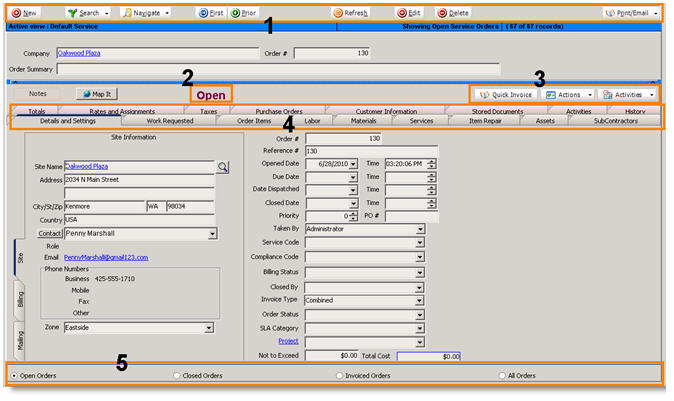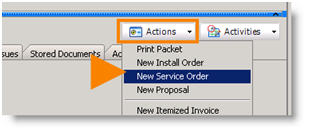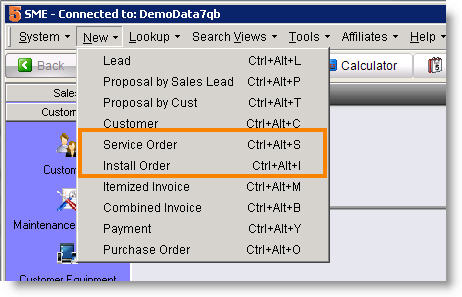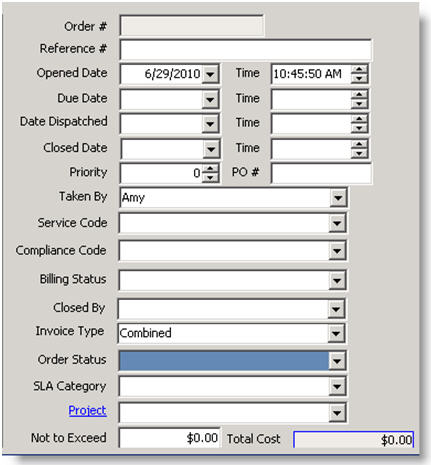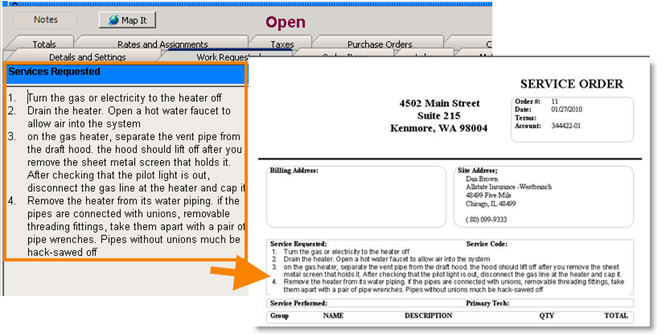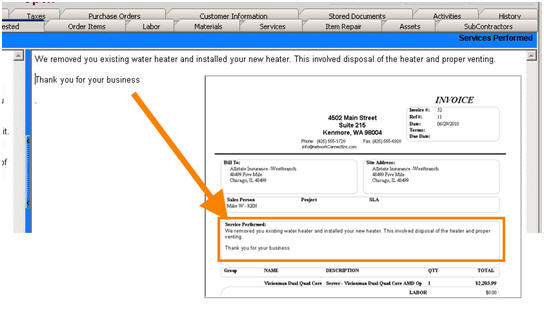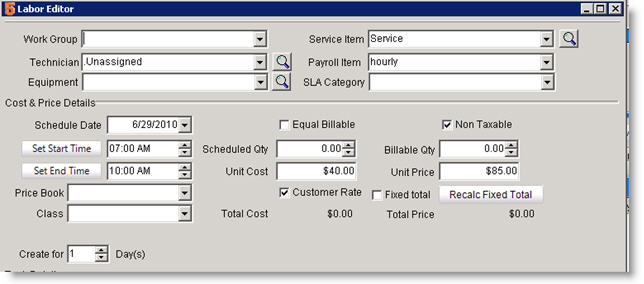Service & Install Orders
The service or install order records the location of the job, specifies the work to be completed and includes products, services or labor hours required for the job. The order will show the billing address, the total order and tax amount, and related purchase orders. An order is created for a customer. Material added to an order is linked to SME’s Inventory module. Labor added to an order is linked to SME’s Order Dispatch window.
Orientation
Below are the different sections of a service or install order. Depending on the permissions your SME Administrator created, you may not have access to all the areas described below.
1
New – Create new order
Search – Search orders
Navigate – Jump to order by order number
First, Next, Prior, Last – Tab through orders
Refresh – Refresh window to see calculated fields update.
Edit – Click to make changes to the order.
Delete – Delete the order.
Print/Email – Print or email the order. The printed orders, or reports, can be customized in the reports module.
2
Order Status -Open, Closed or Invoiced. Separate from the Order Status field on Details and Settings.
3
Action – Close an order, invoice an order, or create PO for order.
Activities- Set reminder activities for order.
Quick Invoice- Quickly generates an Itemized or Combined invoice. (To generate a Partial, Fixed Total, % of Total or Dollar Amt invoice, must use the Actions menu and select Generate Invoice.)
4 - Access order details and customer information using these tabs. These tabs can be hidden for certain user groups as needed.
5 - Select a filter to view open, closed, invoiced or all orders.
Create a new Service or Install Order
You can create a new order from a customer record or directly in the Service or Install module. If you need to create an order for a new customer, first create the customer record, then create the order.
From a customer record:
1. Open customer record.
2. Click Actions, New Service Order or New Install Order.
From the Service or Install module:
1. Click New.
2. The Search window will open. Double click on the customer you want to create the order for.
3. A new order is created. The customer information will populate the order such as site, billing and mailing information, the invoice type, the customer price book, and the customer’s tax group.
From anywhere in SME:
- Click New in the menu at the top of SME.
- Select Service Order or Install Order.
You can type Ctrl+Alt+S to create a new service order, or Ctrl+Alt+I to create a new install order.
Details and Setting Tab
The site, billing and mailing information is pulled from the customer record. On the right, there are fields specific for this order. Below is a description of the fields.
Order # - when the order is saved, the order number is populated. This is a unique number you can use to look up orders.
Reference #- The order number is populated into this field, but you can change it. This field is sometimes used to type a reference number you customer may want you to use.
Opened Date – auto-populated with the date you created the order.
Due Date – You can select a date this order is due. If the order is not closed by this date, the order will show as red on the dispatch board. Note- Your SME Administrator may have changed the overdue color.
Date Dispatched – Date field to select the date your technicians are dispatched. This field is not auto-populated and you must select the date.
Closed Date – This field will be auto-populated with the date you close the order.
Priority – Select a priority and you can sort orders by priority in the Search window.
PO # - Type the related purchase order number for reference.
Taken By – Name of SME user that created order will populate this field.
Billing Status – If you are syncing SME with QuickBooks, the billing status drop down will be imported. Here you can void an order so it doesn’t sync with QuickBooks when invoiced.
Closed By – Name of SME user that closed the order will populate this field.
Invoice Type – Select the type of invoice you want to use for the order. See the Invoicing an Order section of this guide to read about your invoicing options.
Order Status – Your SME Administrator may have customized this drop down list. This field should reflect the milestones you move your orders through such as “materials ordered” or “ready to schedule”.
SLA Category –Allow you to designate the entire order into a Service Level Agreement category such as comprehensive, labor only, parts only, etc. These categories are fully customizable by the SME Administrator.
Project – Select the project you want this order to be added to. You can create new projects in Projects, in the Customer module.
Not to Exceed – Type your order cost you should not exceed. You can compare it to the Total Cost field to the right.
Total Cost – This field is a calculated field and cannot be edited. It will show you your cost.
Work Requested Tab
There are two sides to the Work Requested tab. On the Services Requested side, the left side, type the services your customer is requesting. This is information your technician will see on a service ticket.
When the job has been completed, fill out the Services Performed side (the right side) with a description of what was completed. This information will show on the invoice that goes to your customer.
Common Services
Your SME Administrator may have set up common services to use when filling out the work requested tab. Common services are templates which can be inserted into this tab.
- Right click on either the Services Requested or Services Performed side.
- Select Common Services
- Select the template name you want to insert
Order Items Tab
On the Order Items tab, you can add labor, materials and services to your order. On this tab, you can hide service, material or labor items from showing on the printed order. You can also rearrange the order of items on the order.
Add labor to an order:
On the Order Items tab, click New Labor and the Labor Editor window will open. This is where you will enter the estimated hours required for your technicians, the hours you are billing the customer, the type of service they are performing, select the technician (if you know the technician) and the date of the service.
Technician – Select the technician that will work on this order. If you don’t know who will do the work, select Unassigned and your dispatch manager will select the technician when the order is ready to schedule. If your SME Administrator set up Work Groups, you can filter your Technician list by selecting a Work Group.
Service Item – Select the type of service you are charging the customer for. This updates the Unit Price field.
Payroll Item– Select if your technician is performing regular hourly work, overtime work or other appropriate value. This updates the Unit Cost field.
Scheduled Qty – Enter the hours you need to schedule for your technician.
Equal Billable – Check here if you want the billable qty to equal scheduled quantity.
Billable Qty – Enter the hours you need to bill your customer for. If Equal Billable is checked, this field will be grayed out.
**NOTE** If a price book is set for the customer, the Unit Price field will be auto-populated with the price defined in the price book. The price book overrides the service items, so changing the service item will not change the unit price.
Add material to an order
1. On the Order Items tab, click New Material and the Select Inventory Item window will open.
2. Double click on the item you need to add to the order.
3. The Add Items to Order window will open. Notice the description of the material and the price and cost at the bottom. The cost is determined by the inventory item. The Price is determined first by the price in the inventory item, but if your customer has a price book assigned, the price book drives the cost.
4. Update the quantity if needed.
5. Click OK.
The material is added to the order. You inventory manager will need to select stock or place a PO for material if you do not have stock for this item.
**NOTE** You SME Administrator may have associated labor hours with a material. If so, when you click OK on the Add Items to Order window, the Labor Editor window will open with the Scheduled Qty field populated with the hours.
Add a service to an order
Your SME Administrator may have set up services which you can add to an order. Examples of a service might be “inspection level 1 service” or “hourly subcontractor work”.
**NOTE** When you add a service to an order, it will not show on the dispatch calendar. Only adding labor will show on the Order Dispatch window.
Add text to order items
You can add text to your order as shown in the image on the right. This can be used to group items on your order together under a description.
1. Click New Text.
2. A text line is entered on the Order Items tab. Note the Item Type is Text.
3. On the line that was created, click in the Item Text column and type your text.
Rearrange order on Order Items tab
- Click on the line you want to move.
- Click your cursor in the Sequence column.
- Use the to change the order.
**NOTE**If you don’t see a column for Sequence on the Order Items tab.
- Right click the column header on the Order Items tab.
- Select Add Columns to Grid.
- In the window that opens, drag the Sequence field and drop it in place on the Order Items tab.
Labor, Material and Services tabs
The labor tab only shows labor for the order, the Materials tab only shows material for the order, and Services tab only shows service for the order. SME users that are responsible for dispatch may want to use the labor tab and only see labor items. SME users that are responsible for inventory and ordering parts may want to use the Materials tab to only see material on the order.
